Over Cardigan and Through the Woods - Day 2
September 26, 2016
By Emma H.
Yellow Group D2 B3
*During our sketches and transects, we took absolute location of the area*
The day started at 6:30, earlier than the morning before. First we heard feet pounding down the stairs, and this arose all three of us in our bunk room. Clambering around for the light, we all get up and Livvie goes to ask Mrs. Allen (Natalie's mom) what time it is, in fear of it being past 7:00pm, our waking time. The environment affects us humans by it getting light outside causing our bodies to send a singal to wake up. Since, we are already awake, we figure we'll just get dressed and head downstairs in hopes of being early to breakfast. Glad that my group didn't have to set up for breakfast, I drowsily sit down and am served eggs with bacon and delicious croissants. I shove myself full of food and promptly head back upstairs to get ready for our hike up Firescrew and Cardigan. I put on multiple layers thinking it will be freezing during the hike.
Our group meets outside after all of our bags have been packed and make a plan of at what elevations we are going to take sketches and transects. Then, we are on our way. On our way down the trail, we see the apple trees by the side of the trail. They are an example of human-environment interaction in a good way because humans planted them and they are keeping nature alive and thriving. We take the same trail (which humans made for people to explore nature) as we did yesterday for a little while before merging onto a different one.
Our first stop of the day was at the first intersection we encountered. Right next to where I put my bag down was a plush spruce tree, so decided to draw it.
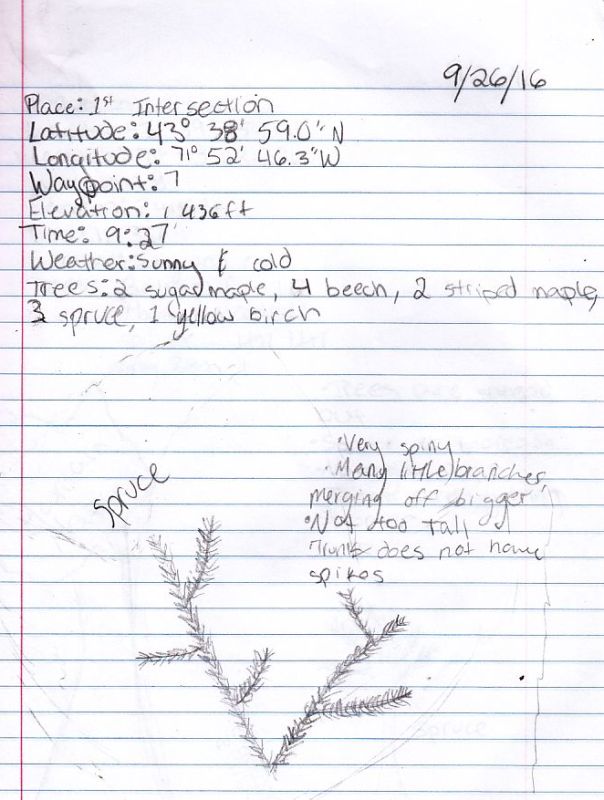
Also, around this spruce tree, we did something called a transect. It was our first of the day. A transect is where you throw a line of string into the forest and you list the trees that are at arm's length away. The tree we found the most of here were beech trees. Within a few feet of rope, there were four! At this point in time, we really hadn't started hiking upwards yet, for we were at almost the exact same elevation of the lodge. Already hot, I scurry into the woods to take off my fleece layers. At one point, we took a wrong turn. We started to head up a large rock and not the trail, until Mrs. Allen noticed there weren't any trail markers the way we were heading. Before we left this area though, Fern showed us something called reindeer lichen. It belongs to the kingdom fungi. We gently felt it, and it had a very dry and bristly texture. But, when Fern poured some water on a piece of lichen, we felt it once again and this time it felt soft. This was a way we affected the environment in a good way. We provided the lichen with some essential nutrients it needs to live.
The second stop we made was for a snack. After climbing almost a thousand feet in elevation, I think we deserved a break. Before this time, there had been a lot of red lights (Fern's way of telling us to slow down), and I knew there was more to come as we neared the summit of the mountains. I drew a mountain maple tree and we took our transect.
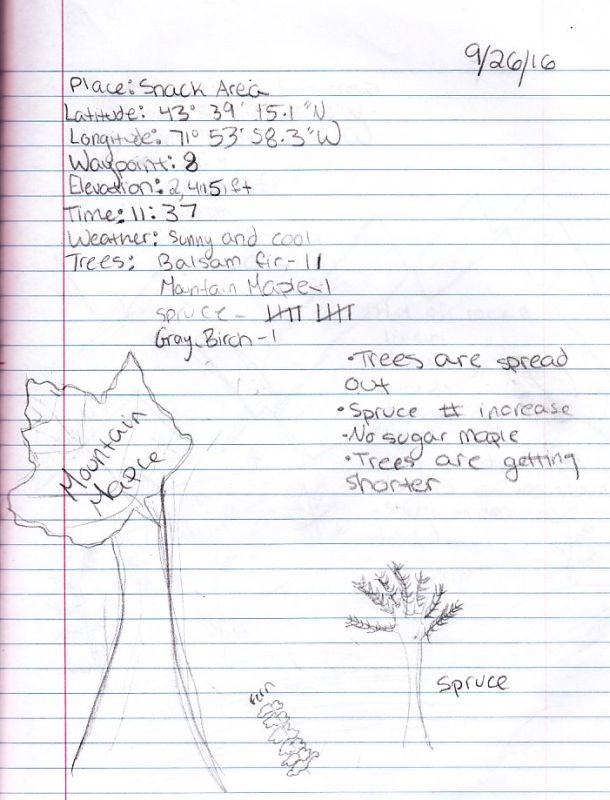 |
This sketch is mostly of a mountain maple. I traced it's leaf and then put it on a trunk. Though a mountain maple tree is not made of one leaf, those are the leaves that cover it's branches. |
Here there turned out to be many spruce trees. Ten to be exact. Fortunately, for those hungry for more than a granola bar, and not wanting to eat their lunch just yet, Fern had some trail mix. I was one of the people who didn't want to eat my sandwich just yet. That morning I had made a turkey sandwich with vegetables and had packed a granola bar and a cookie and apple from the lunch bar they provided. Every hiker has to have some trail mix on a hike. We held our hands out gratefully as she poured some in. After our stomachs were full and we had done a quality sketch, we got ready to move on.
As we started to leave, you could see that we left a few scattered nuts on the forest floor. This is an example of bad human-environment interaction. The reason being that different animals in the thick of the woods have certain diets they follow to keep healthy. By leaving food around that cannot be found in nature, who knows how certain animals will react to this unknown food? Sadly though, this incident also affected us humans in a bad way. After spilling trail mix, this means that we don't have as much food to eat. If we were less hygienic, we might eat the nuts off the ground, but we don't know what has been on the forest floor, and we may even say they are contaminated. Not to long after this, we decided to stop at a place with a beautiful view for lunch. I just couldn't stop taking pictures!
After we left the snacking area behind, we ascended about a thousand more feet in elevation before we reached the summit of Firescrew. When we had finally thought we got to the summit, it turned out the summit was still a ways in the distance. So, it turned out all our celebration was for nothing. Already tired, we hiked toward the actual summit. But, before this we stopped to take a sketch and third transect.
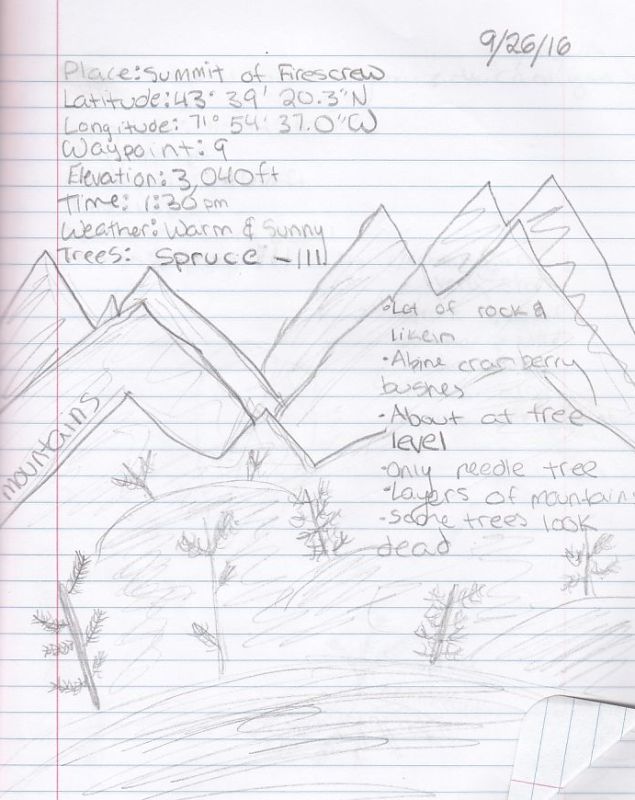
As a result of our group being so high in elevation, there were very few trees we found, and the three we did were all spruce. As I put on my jacket, I agreed with the spruce crouched against the wind of it being so cold. Though the jacket made from materials from the environment affected me well by keeping me warm, the jacket did not benefit the environment. All the materials it was made of were from the environment, and when they were picked or harvested to make the coat, we derived nature of its natural resources. At this time, Mr. Woolner joins our group and we head towards Mount Cardigan, where the summit is very clear.
The next stop was not too far away from the previous one. It was a the lowest point between Firescrew and Cardigan. From here, the fire tower at the top of Cardigan looked like a spaceship. During our transect, we found only three spruce once again and a lonely mountain birch. I traced the leaf and drew a spruce that was crouched low, away from the wind.
I clamber up the hill to the summit of Cardigan, and the view is breathtaking, but is also cold like Firescrew.
 |
| This is a sketch of the top of Cardigan Mountain. From the summit you could see many more mountains in the distance as well as the rest of the bare rock summit of Cardigan Mountain. Like I mentioned, there was a small pool with cottongrass in it. |
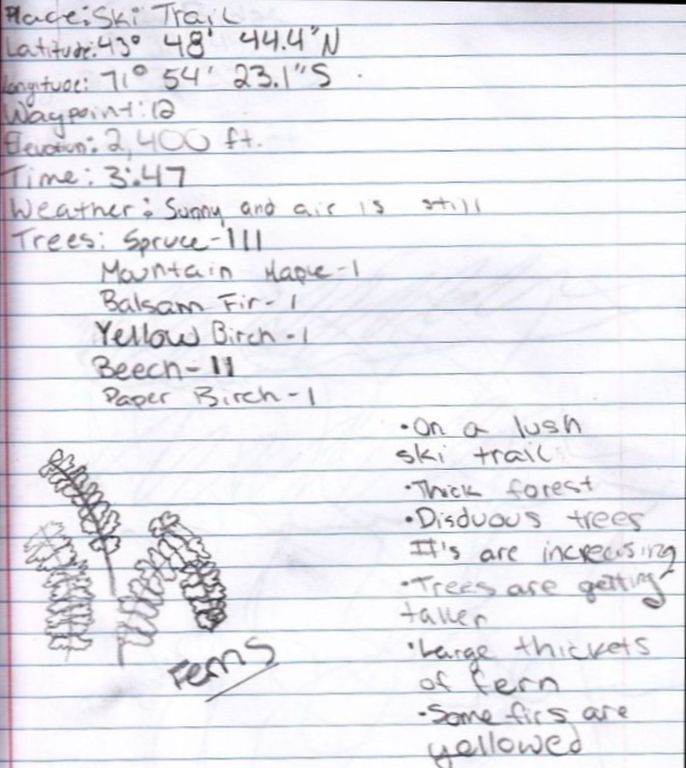 |
We took another sketch here and I sketched ferns. There were way more trees here as opposed to the top of Cardigan. There were mountain maple, spruce, balsam fir, yellow birch, beech and paper birch. Throughout the hike back, we all participated in a heated discussion about if rocks are living or dead.
A little ways farther down the trail we encountered a bridge called the Crew Bridge.
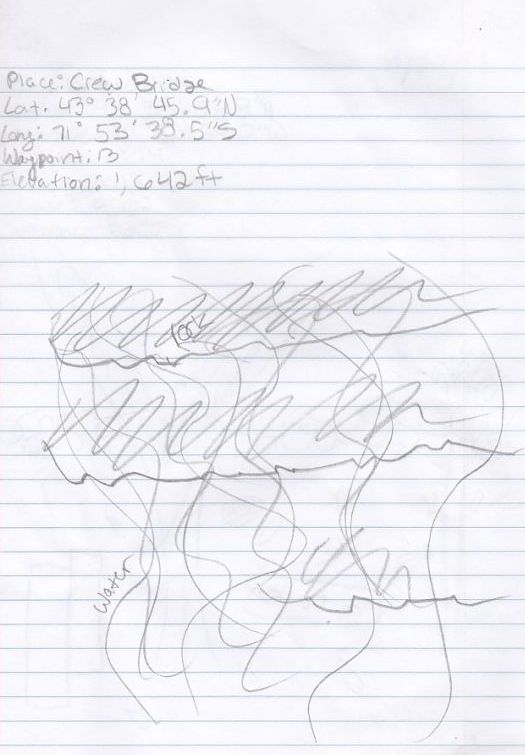
This time there was some water underneath it, so I drew that. The bridge itself is human-environment interaction because humans have built the bridge in nature. This is an example of good human-environment interaction, for humans have made these trails more accessible by building the bridges. This turned out to be our last stop before heading back to the lodge for dinner.
This time our job was to set up for dinner. We had chicken that was coated in mustard and bacon bits, rice and and a garden salad. All this food is an example of human-environment interaction. We killed animals and plants so we could eat them. I try not to think of how bad this sounds when I am eating. But, this food from the environment has also affected us in a good way because the environment provided the food that we need to live. For dessert we had massive pieces of spice cake. Delicious! After hiking all day, we all were drowsy. The environment had affected us in a good way because when we hiked the trails, this helped us exercise. We then listened to Mr. Woolner's really cool story about a grouse and a book his uncle wrote and then went to bed for the night, with our new roommate Julia who had moved to our room so she wouldn't get sick. The germs from the environment had already affected her old bunkmates in a bad way by making them sick.
Back to the Index Page
Onto Day 3.

Postcard Image by E.H. is licensed under a Creative Commons Attribution-NonCommercial-NoDerivatives 4.0 International License.